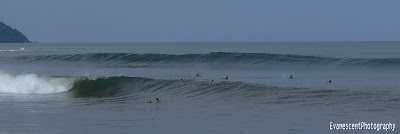Fall has always been my favorite season. Having grown up on the east coast, I always looked forward to this time of year. The fall brought crisp, cool air and brightly colored foliage. You could smell wood burning in fireplaces and hear kids crunching through piles of leaves. It was the start of football season and hosted two of my favorite holidays--Halloween & Thanksgiving. It meant scarves & beanies, and bonfires with friends. No fall was complete without a trip to the pumpkin patch, a haunted hayride and at least one viewing of It's the Great Pumpkin, Charlie Brown.
When people ask me if I miss the east coast I usually say "I miss the fall." But in reality the fall here in SD is pretty rad. I still enjoy a lot of the same things I did back east, but now I have the beach and the surf. Offshore, Santa Ana winds, foggy am surf sessions, rainy days at the beach... Yes I still miss the fall foliage, but in it's place are the beautiful, bright sunsets that are characteristic of fall in San Diego.
Ever wonder why autumn and winter sunsets are more vivid??
To understand you must first know a little about the colors of the rainbow. Blue light has a short wavelength, therefore it gets scattered easiest by air molecules. Red and orange light have longer wavelengths so they are not scattered as much. As the sun rises and sets, light from the sun must pass through the atmosphere before it reaches our eyes. As it passes through the atmosphere it comes into contact with molecules in the air. As this happens the blue light gets scattered away and the reds and oranges become more pronounced. You with me so far??
During the winter and fall, weather patterns allow for the dry, clean Canadian air to sweep across the country. Therefore more colors of the spectrum make it through to our eyes without getting scattered by particles in the air. This produces brilliant sunsets and sunrises that can look red, orange, yellow or even pink. Clouds can also impact the magnificence of a sunset. Clouds catch the last red-orange rays of the setting sun and the first light at dawn. To produce vivid sunset colors the clouds must be high enough to intercept sunlight which has not suffered color loss by passing through the boundary layer of the atmosphere. The boundary layer contains the most dust and haze. Dust and haze do not enhance sky colors, they actually subdue them. Clean air is the main ingredient common to brightly colored sunrise and sunsets.
To understand you must first know a little about the colors of the rainbow. Blue light has a short wavelength, therefore it gets scattered easiest by air molecules. Red and orange light have longer wavelengths so they are not scattered as much. As the sun rises and sets, light from the sun must pass through the atmosphere before it reaches our eyes. As it passes through the atmosphere it comes into contact with molecules in the air. As this happens the blue light gets scattered away and the reds and oranges become more pronounced. You with me so far??
During the winter and fall, weather patterns allow for the dry, clean Canadian air to sweep across the country. Therefore more colors of the spectrum make it through to our eyes without getting scattered by particles in the air. This produces brilliant sunsets and sunrises that can look red, orange, yellow or even pink. Clouds can also impact the magnificence of a sunset. Clouds catch the last red-orange rays of the setting sun and the first light at dawn. To produce vivid sunset colors the clouds must be high enough to intercept sunlight which has not suffered color loss by passing through the boundary layer of the atmosphere. The boundary layer contains the most dust and haze. Dust and haze do not enhance sky colors, they actually subdue them. Clean air is the main ingredient common to brightly colored sunrise and sunsets.
Here are a few pictures of San Diego's fall colors... (last night in Ocean Beach)






 Pin it
Pin it Share This
Share This Tweet This
Tweet This


































